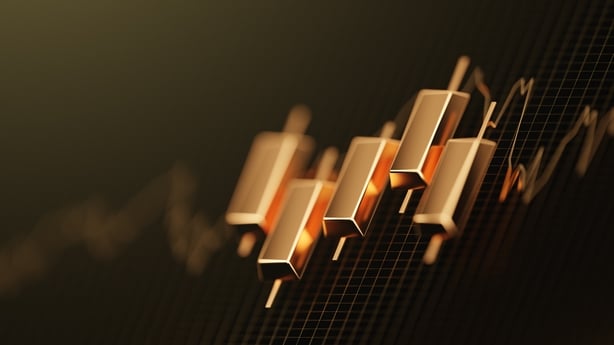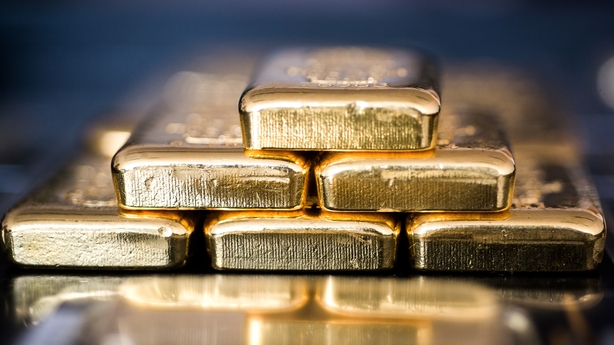For those of us able to, investing in gold is now de rigueur and a prudent strategy for a balanced portfolio especially in uncertain times. John Lowe of MoneyDoctors.ie gives the background.
If the so-called 'gold bugs' - investors who believe passionately in the long-term value of buying gold - are right, then this could be a good time to add a little glitter to your portfolio.
Over the last few years, we have seen massive swings in the price of gold from its once all-time 1980 high then of US$850 a troy ounce - in today’s money, about $2,500 - to its current price of c. US$2,315 (c. €2,143.52) per troy ounce (slightly heavier than our school-days avoirdupois).

Last month, gold reached its highest ever price at $2,431 per troy ounce. Gold is now a barometer of volatility in the world - and due to its effect on the financial markets plus a natural desire to stay solvent and have an asset that is easily bartered and negotiable, gold could still be the very commodity to continue rising in price. Remember, they say for that balanced portfolio you should have 10% of an investment portfolio in precious metals.
There are three sound reasons to believe that prices will rise.
Firstly, the growing economies of Asia and the Middle East have resulted in a huge surge in demand – especially for gold jewellery. For proof one need look no further than global gold jewellery sales, which increased at a very steady pace over the last few years.
Secondly, a rising number of private investors all over the world have been putting some or all of their savings into gold as a hedge against economic or political instability across the globe.
Economies, currencies and countries fail, so when investors feel the future is uncertain (as many think at the moment) demand for gold always surges. This is doubtless in no small part due to the fact that the price of gold tends to move in the opposite direction to virtually all other conventional asset classes – making it ideal when investors wish to diversify. It is also a standard and easy to buy/sell.

Thirdly, the mining industry can’t keep up with demand. Figures show that in excess of 4,000 tonnes of gold were purchased, but only 2,700 tonnes were mined back in 2011, 2,860 tonnes in 2014 – 260 tonnes more than the previous highest peak in 2001.
What’s more, production is falling by an average of 4% a year and it will take the industry anything up to ten years to increase supply by the required volume. In the past, when demand outstripped supply, the shortfall was met by many of the world’s central banks. No longer.
Countries, which had been disposing of their gold reserves, have slowed down sales or even stopped selling altogether. Many central banks, notably those of Russia, Iran and China, are actually now buying bullion.
Although I believe that gold prices are likely to carry on moving upward with the continuing economic uncertainty, I would only suggest buying if you already have a range of other investments including shares, bonds and property.
If you are interested, these are the four ways of investing in gold that I would recommend:
1. Gold bullion
Gold bullion coins and bars weighing nearly 2,000 troy ounces (over 60 kilos) and worth more than €2 million recently transferred in recent weeks into the country from the UK. This is believed to be the largest legitimate movement of gold bullion into Ireland in decades.
Brexit, of course, is helping but the leading bullion dealer in Ireland, GoldCore, said it is seeing a growing preference amongst Irish investors to store their gold domestically here rather than Perth, Zurich, Singapore, Hong Kong, Singapore and especially London.
Gold held in the company’s Dublin vaults is a fraction of GoldCore’s client holdings in other jurisdictions, it has already surpassed Hong Kong as a favoured jurisdiction for storing gold with Goldcore clients. Zurich remains the favourite location with client bullion holdings there worth nearly €60 million. Zurich is followed by Singapore, then London, Dublin and Hong Kong.

2. Gold mutual funds
These offer a cost-effective, convenient and potentially more lucrative way to benefit from any increase in gold’s value.
A good example of what a mutual gold fund has to offer is the top-performing Black Rock Merrill Lynch Gold & General Fund has grown well over 1000% since its launch in 1988. The bulk of the UK£1,425 million fund is invested in gold mining shares.
Obviously, gold mining shares rise in line with the value of gold. Your risk is diversified and you can leave it up to the fund manager to choose the best opportunities. There are plenty of funds to choose from and you can pick a fund that matches your own objectives. One fund might aim to track the price of gold, for instance, another to track one of the various market indices such as the FTSE mining index.
An alternative option would be to buy a portfolio of individual mining company shares. On the upside, this will give you greater control and involvement. On the downside, you will have to decide which of the hundreds of different mining company shares to buy. Not my scene.
3. Invest your money in one of the exchange-traded funds (ETFs) for gold
An ETF is listed on the stock market and allows you full exposure to the price of gold, without actually having to take delivery of the bullion. The fund buys and holds the gold, while the investor holds ETF shares. The world’s biggest ETF is Exchange Traded Gold (marketed under different names) which holds over 431 tonnes of the yellow metal. This is more than the Bank of England’s reserves.

4. Perth Mint Gold Certificate programme
The bullion is held in Perth Mint, the only mint in the world guaranteed by a AAA-rated government (the Western Australian government) fee is 2% to 3.9% depending on the amount bought and 1.5% when you sell. Minimum investment is €7,000 but it is safe in every respect. Email me for details.
Incidentally, if you are planning to invest in gold, it is worth noting that it can be held in self-administered pension schemes (SSAPs or Self Directed Trusts for company owners, directors and senior executives), which could mean some tasty tax savings depending on your circumstances.
Leading economist and former IMF executive, Ken Rogoff advises that gold is an "extremely low risk asset" and "investing in and owning gold as a hedge will become more important as it will have enormous value in a cashless society."
Perhaps Shakespeare got it right when he said "the golden age is before us, not behind us".
For more information click on John Lowe's profile above or on his website.
The views expressed here are those of the author and do not represent or reflect the views of RTÉ.

